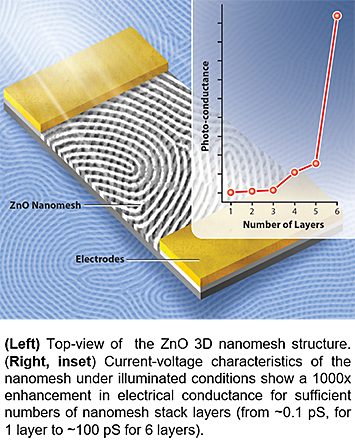Research Highlight: Catching Light with Zinc Oxide Nanomesh Sensors
November 29, 2019
What is the scientific achievement?
CFN scientists and collaborators fabricated nanomesh optical sensors using three-dimensional (3D) block copolymer self-assembly and vapor-phase infiltration synthesis of semiconducting zinc oxide (ZnO). Photocurrent measurements of the ZnO nanomesh sensors show their potential for applications.
Why does this achievement matter?
Self-assembled block copolymers generate unique nano-morphologies that are easily scalable and not possible using other patterning approaches. Infiltration synthesis enabled the conversion of block copolymer patterns into 3D semiconducting ZnO nanomesh, which is a useful electronic material for sensors and devices.
What are the details?
Three-dimensional (3D) nanoarchitectures can offer enhanced material properties, such as large surface areas that amplify the structures’ interaction with environments making them useful for various sensing applications. Self-assembled block copolymers (BCPs) can readily generate various 3D nanomorphologies, but their conversion to useful inorganic materials remains one of the critical challenges against the practical application of self-assembled BCPs. By using the CFN’s world-class expertise in BCP self-assembly and vapor-phase inorganic infiltration, the results not only illustrate a new, large-area scalable, metal oxide thin film nanoarchitecture fabrication method utilizing industry-compatible polymer solution coating and atomic layer deposition, but also represent the first demonstration of the optoelectrical functionality based on the ZnO nanoarchitecture directly generated by the infiltration synthesis in self-assembled BCP thin films.
In addition to developing this general and flexible algorithm, the team deployed the method at an x-ray scattering beamline at Brookhaven National Laboratory. The Complex Materials Scattering (CMS) beamline is operated in partnership between the National Synchrotron Light Source II (NSLS-II) and the Center for Functional Nanomaterials (CFN). The CMS beamline was used to implement this methodology, where the autonomous algorithm selected the sequence of measurements to perform on real material science samples.
CFN Capabilities
CFN Materials Synthesis & Characterization, Nanofabrication, and Electron Microscopy facilities were used in this study.
Publication Reference
A. Subramanian, G. Doerk, K. Kisslinger, D.H. Yi, R.B. Grubbs, C.-Y. Nam, Direct Infiltration Synthesis of Three-Dimensional Electroactive ZnO Nanomesh Using Self-Assembled Block Copolymer Thin Films, Nanoscale 11, 9533 (2019).
DOI: 10.1039/C9NR00206E
https://doi.org/10.1039/C9NR00206E
https://pubs.rsc.org/en/content/articlelanding/2019/NR/C9NR00206E#!divAbstract
Acknowledgement of Support
This research was carried out at the Center for Functional Nanomaterials, which is a U.S. DOE Office of Science Facility, at Brookhaven National Laboratory under Contract No. DE-SC0012704.
2019-16962 | INT/EXT | Newsroom










